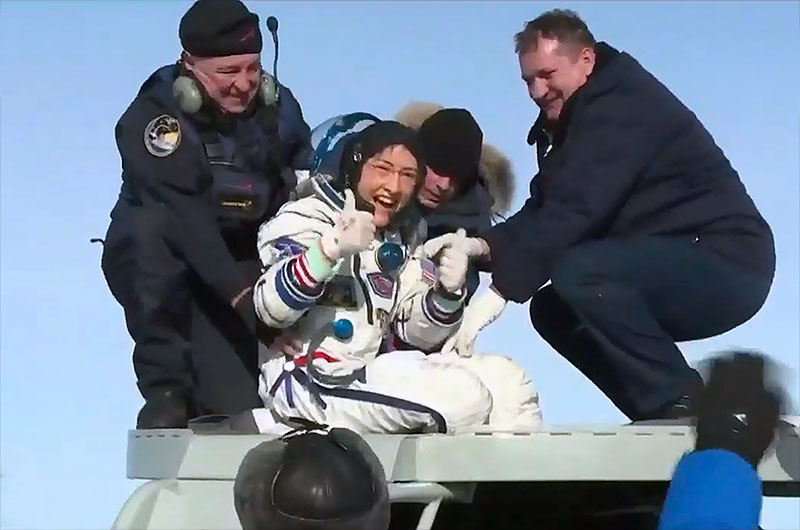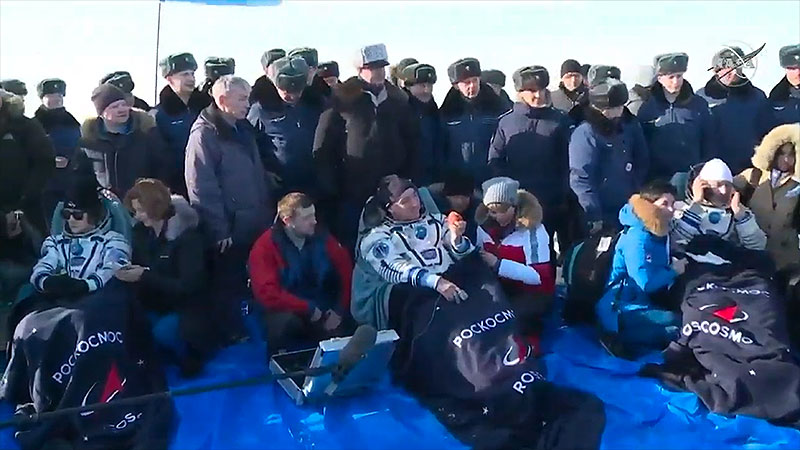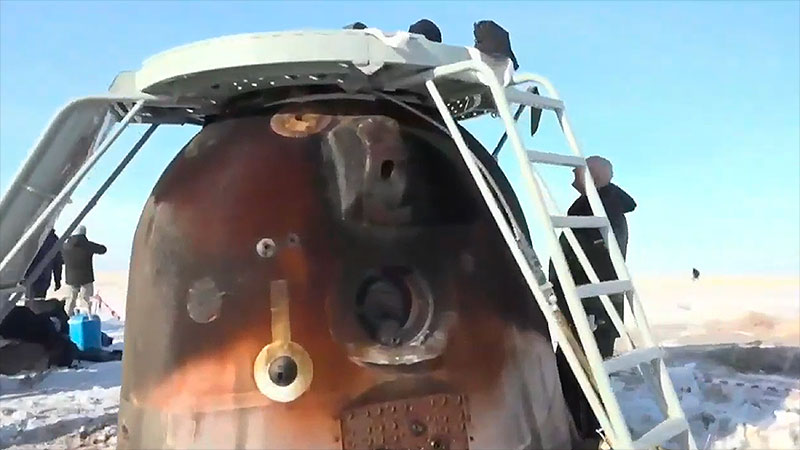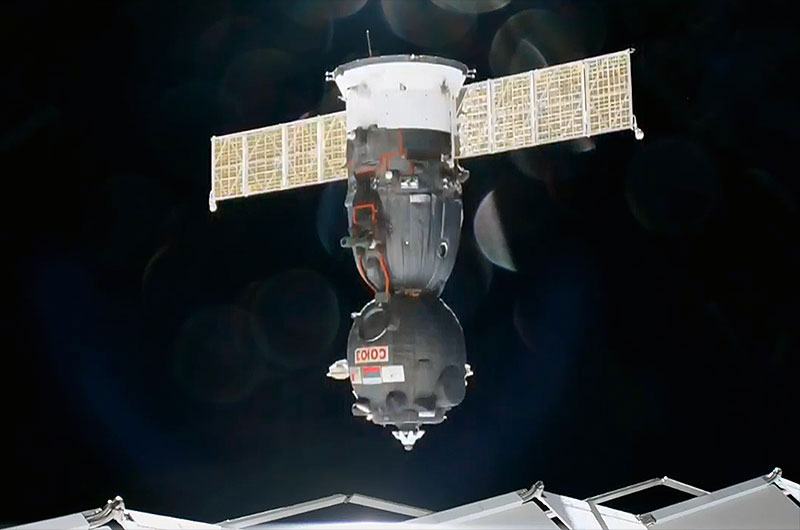Astronaut Christina Koch lands on Earth after record-setting space station mission
Christina Koch did not set out to break records on her first spaceflight, but with her return to Earth after nearly a year in orbit, her mission is now one for the history books.
Koch, a NASA astronaut, landed on the snow-covered steppe of Kazakhstan on Thursday (Feb. 6) with two of her International Space Station (ISS) crewmates, Expedition 61 commander Luca Parmitano of the European Space Agency (ESA) and cosmonaut Alexander Skvortsov of the Russian space agency Roscosmos.
Descending under a parachute and further slowed by braking thrusters, the three touched down aboard Russia's Soyuz MS-13 spacecraft southeast of the Kazakh town of Dzhezkazgan at 4:12 a.m. EST (0912 GMT or 3:12 p.m. local time).
Related: The science of Christina Koch's near-year in space in photos
In Photos: See the Soyuz landing in pictures in these amazing images

Russian recovery forces, as well as NASA and ESA medical personnel, arrived quickly at the landing site to assist Koch, Parmitano and Skvortsov out of the space capsule and to conduct brief physical exams as the three crewmates began adjusting to the pull of gravity again.
"Everyone says that getting back into gravity is such a surprise, because you suddenly have to work to raise your own arms and, of course, your legs," Koch said in a media interview a few days before experiencing her first landing. "I haven't even had to hold up my own body weight in a long time, so we will see how that goes."
Koch, Parmitano and Skvortsov all appeared to be in good spirits, as they felt the chill of the open air for the first time since leaving Earth.
Get the Space.com Newsletter
Breaking space news, the latest updates on rocket launches, skywatching events and more!
"I'm so overwhelmed and happy right now," Koch said a few minutes after landing.
Related: Record-Breaking astronaut Christina Koch talks female space records
The landing brought to an end Koch's 328 days in space, a new duration record for a single space mission by a woman. Parmitano and Skvortsov, who launched after Koch, returned to Earth after 201 days.
"There are many people on the ground [who] are taking counts of what we have done — how many EVAs [extravehicular activities or spacewalks], how many hours of work, how many experiments, how many days we have spent up here — none of those are important," said Parmitano, addressing his station crewmates during a change of command ceremony on Wednesday. "What is important is what you achieved. You, as the crew, made all of this possible. It has been your incredible, incredible dedication that has made it all possible."
Parmitano, Skvortsov and Koch undocked their Soyuz at 12:50 a.m. EST (0550 GMT). Their departure from the Poisk mini-research module (MRM-2) marked the official end of Expedition 61. Cosmonaut Oleg Skripochka and NASA astronauts Jessica Meir and Andrew Morgan remained on the station to begin Expedition 62.
Related: The amazing spacewalks of Expedition 61 in photos

Koch arrived aboard the orbiting laboratory on March 14, 2019, to join the 59th expedition crew. Originally slated to to return to Earth after just six months, her stay was extended to collect data about the physiological effects of long-duration spaceflight. In December, Koch surpassed the previous record set by a woman — 289 days by NASA astronaut Peggy Whitson in 2017 — and has now completed the second longest single spaceflight by an American astronaut after Scott Kelly, who logged 340 days in 2016.
During her time as a member of the Expedition 59, 60 and 61 crews, Koch participated in more than 210 science investigations, including research into how the human body adjusts to the stresses of spaceflight and protein crystallization growth in support of developing cancer treatments. She also assisted in the robotic capture of uncrewed resupply spacecraft, including SpaceX's 19th Dragon and Northrop Grumman's 12th Cygnus cargo vehicles.
In addition, Koch performed six spacewalks, totaling 42 hours and 15 minutes, to upgrade the batteries for two channels of the space station's solar arrays. She conducted three of the excursions with Meir, setting another record for the first-ever extravehicular activities by an all-women team.
"When we first got the go to come out of the airlock ... we were holding onto a handrail and we just caught each other's eye, we knew [then] how special that moment was and I'll never forget that," said Koch of her first spacewalk with Meir on Oct. 18, 2019.
Over the course of the 328 days, Koch orbited Earth 5,248 times, traveling 139 million miles (224 million kilometers), or the equivalent of about 291 round trips to the moon.

"Milestones are important, and I think they are important for a couple of reasons," said Koch. "They get the conversation going about where we are in the state of the art of human exploration."
"The second aspect is inspiration," she continued. "I think some people draw inspiration from milestones and from things they have seen someone work hard to achieve."
Koch, who now ranks seventh on the list of U.S. space travelers with the most time in space, was not the only record-setter who returned to Earth on Thursday. Completing his second mission, Parmitano has now logged a total of 367 days in space, more than any ESA astronaut in history.
Parmitano also now holds the record for the most time on EVA by a European at 33 hours and 9 minutes. Four of his six career spacewalks were devoted to the repair of the Alpha Magnetic Spectrometer cosmic ray detector, which involved the most complex EVA work since the servicing of the Hubble Space Telescope.

Skvortsov, who has spent 546 days off the planet on three missions, now ranks 15th on the all-time spaceflight endurance list.
From their landing site the three will be flown by helicopter to Karaganda, where they will be greeted by a traditional Kazakh welcome ceremony. From there, Koch and Parmitano will board a NASA jet for Cologne, Germany, where Parmitano will be met by ESA officials before Koch continues to Houston. Skvortsov will be flown by a Gagarin Cosmonaut Training Center aircraft to his home in Star City, Russia.
Soyuz MS-13 was the 59th Soyuz to launch for the International Space Station. It traveled 85.2 million miles (137 million km) completing 3,216 orbits of Earth.
- Women in space - A Gallery of firsts
- Historic women spacewalkers hope to land on the moon
- Kelly Clarkson just called 2 NASA astronauts in space. Here's what they said (video)
Follow collectSPACE.com on Facebook and on Twitter at @collectSPACE. Copyright 2020 collectSPACE.com. All rights reserved.

Join our Space Forums to keep talking space on the latest missions, night sky and more! And if you have a news tip, correction or comment, let us know at: community@space.com.

Robert Pearlman is a space historian, journalist and the founder and editor of collectSPACE.com, a daily news publication and community devoted to space history with a particular focus on how and where space exploration intersects with pop culture. Pearlman is also a contributing writer for Space.com and co-author of "Space Stations: The Art, Science, and Reality of Working in Space” published by Smithsonian Books in 2018.In 2009, he was inducted into the U.S. Space Camp Hall of Fame in Huntsville, Alabama. In 2021, he was honored by the American Astronautical Society with the Ordway Award for Sustained Excellence in Spaceflight History. In 2023, the National Space Club Florida Committee recognized Pearlman with the Kolcum News and Communications Award for excellence in telling the space story along the Space Coast and throughout the world.










